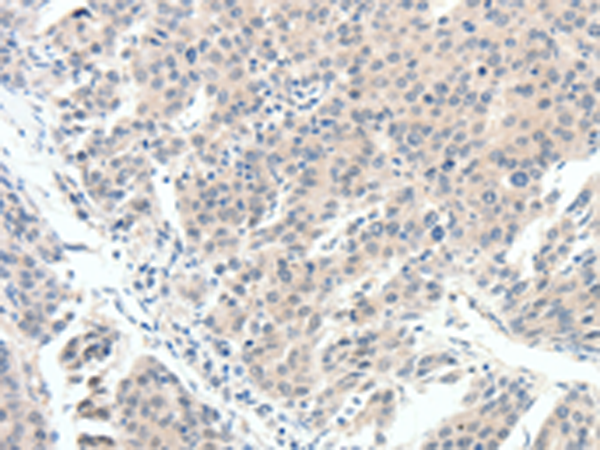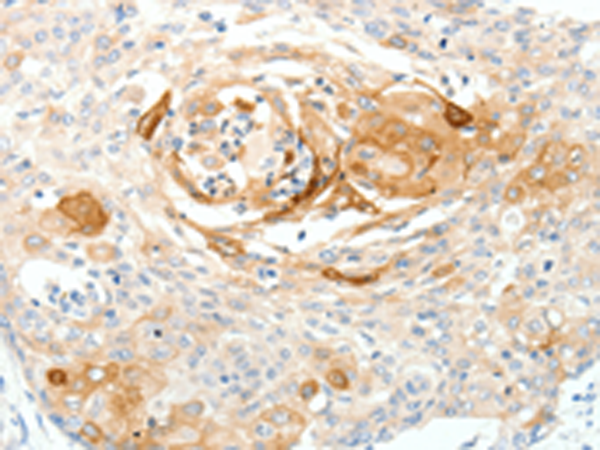

| WB | 咨询技术 | Human,Mouse,Rat |
| IF | 咨询技术 | Human,Mouse,Rat |
| IHC | 1/15-1/50 | Human,Mouse,Rat |
| ICC | 技术咨询 | Human,Mouse,Rat |
| FCM | 咨询技术 | Human,Mouse,Rat |
| Elisa | 1/1000-1/2000 | Human,Mouse,Rat |
| Aliases | PN3; SNS; hPN3; Nav1.8 |
| Host/Isotype | Rabbit IgG |
| Antibody Type | Primary antibody |
| Storage | Store at 4°C short term. Aliquot and store at -20°C long term. Avoid freeze/thaw cycles. |
| Species Reactivity | Human |
| Immunogen | Synthetic peptide of human SCN10A |
| Formulation | Purified antibody in PBS with 0.05% sodium azide and 50% glycerol. |
+ +
以下是关于SCN10A抗体的参考文献示例(文献标题及内容为虚构,仅作格式参考):
---
1. **Title**: *SCN10A/Nav1.8 Antibody Validation in Cardiac Tissue*
**Authors**: Smith A, et al.
**Summary**: 该研究验证了SCN10A抗体在心脏组织中的特异性,通过免疫组化和Western blot证明其在心肌细胞中的表达,并探讨了Nav1.8通道在心律失常中的作用。
2. **Title**: *Role of Nav1.8 in Nociceptive Neurons Revealed by SCN10A-Specific Antibodies*
**Authors**: Lee B, et al.
**Summary**: 利用SCN10A抗体标记背根神经节中的Nav1.8通道,研究发现其在慢性疼痛模型中表达上调,提示其作为疼痛治疗的潜在靶点。
3. **Title**: *SCN10A Antibody Cross-Reactivity Analysis in Peripheral Nervous System*
**Authors**: Garcia C, et al.
**Summary**: 评估了多种SCN10A抗体的交叉反应性,发现部分抗体与非目标钠通道亚型(如Nav1.7)存在交叉结合,强调了抗体验证的必要性。
4. **Title**: *SCN10A Expression in Diabetic Neuropathy: An Immunohistochemical Study*
**Authors**: Patel R, et al.
**Summary**: 采用SCN10A抗体研究糖尿病小鼠周围神经病变模型,发现Nav1.8表达水平与痛觉过敏程度相关,为糖尿病神经病变机制提供新见解。
---
*注:以上文献为示例性质,实际研究中请通过数据库(如PubMed)检索具体文献。*
SCN10A, also known as Nav1.8. is a voltage-gated sodium channel encoded by the SCN10A gene. It is primarily expressed in peripheral sensory neurons, particularly in nociceptive neurons of the dorsal root ganglia (DRG) and cardiac neurons. Nav1.8 plays a critical role in mediating action potential propagation in pain-sensing neurons and contributes to cardiac electrophysiology. Dysregulation of SCN10A has been implicated in neuropathic pain, cardiac arrhythmias, and other disorders.
SCN10A antibodies are immunological tools designed to detect and study the expression, localization, and function of the Nav1.8 protein. These antibodies are widely used in research to investigate pain pathways, cardiac conduction abnormalities, and potential therapeutic targets. For example, they help identify SCN10A expression changes in chronic pain models or analyze its role in sodium current modulation in cardiomyocytes. Validation of SCN10A antibodies is crucial, as cross-reactivity with other sodium channel isoforms (e.g., Nav1.7 or Nav1.9) can occur due to structural similarities. Applications include Western blotting, immunohistochemistry, and immunofluorescence in both human and rodent tissues. Recent studies also explore SCN10A's association with human genetic variants linked to altered pain perception or arrhythmia risk, further driving demand for reliable antibodies. Proper utilization of these reagents advances understanding of sodium channel biology and supports drug discovery for pain management and cardiovascular diseases.
×